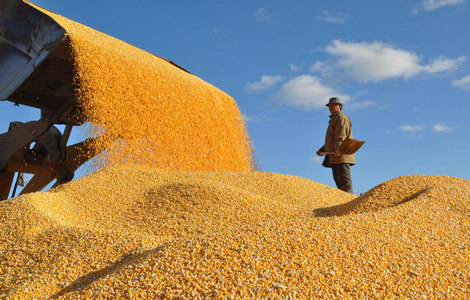
The Borlaug Global Rust Initiative, an international network devoted to study wheat diseases, opened a technical workshop with the Chinese Academy of Agricultural Sciences in Beijing on Friday.
Wheat experts from around the world attended the meeting and discussed breakthroughs in technology used to resist wheat disease, a fungal disease that affects cereal crops.
He Zhonghu, a professor at the academy of social sciences, said China's area of wheat production has decreased by 20 percent in recent years. The total production of the crop remains the same thanks to an increase in its yield per unit, yet the crop has become more vulnerable disaster and wheat rust has become a greater threat.
The Borlaug Global Rust Initiative was established in 2005 to honor Norman Borlaug, a US agronomist and Nobel Peace Prize laureate, for his great contribution to maintaining the world's food supply.
The initiative's purpose is to reduce the dangers of wheat rust and promote the establishment of an international system that can be used contain the disease.
Another goal is to track the spread of Ug99, a disease that arose from a mutation of stem rust. It was first discovered in 1999 in Kenya.
"This is the most damaging disease for wheat," said Dave Hodson, an expert with the Borlaug Global Rust Initiative who has spent years conducting field studies in Ethiopia. "Although stem rust has almost been controlled in all the areas in the world other than Eastern Africa in the 1990s, many mutated diseases have risen again."
Many disease-resistant wheat types lose their capacity to fight off rust in three to five years, He said. The Borlaug Global Rust Initiative therefore has bred strains of the crop that have the ability to put up long-term resistance.
"Wheat rusts are global travelers with no respect for political boundaries," Hodson said. "Effective control often depends on finding out what is happening in distant regions."
He plans to encourage farmers to use cell phones and other mobile devices to help them better observe the spread of the disease.
Ug99 is the chief cause in the 30 percent decline that was seen in Kenya's wheat yield in 2007. After being spread widely in East Africa and West Asia and causing severe damage to corps, the catastrophic disease has become a threat to China, where it is likely to be carried to in the wind, according to the Borlaug Global Rust Initiative.
He said China has sent samples of more than 1,200 kinds of wheat to a lab in Kenya to test their resistance to Ug99 and only 16 turned out to be not susceptible to the disease.
"If the wolf has to come, we'd better get prepared," says Kang Zhensheng, the head of a wheat lab from Northwest Agriculture and Forestry University. "We are breeding new Ug99-resistant wheat types, and cooperating with the initiative to develop a surveillance system to track the disease."







